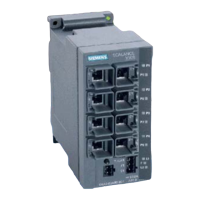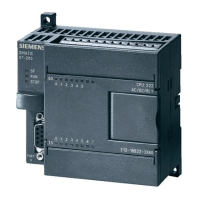Operating Your Text Display (TD) Device
5.5 Viewing the Screens and the Alarms
Text Display (TD) User Manual
System Manual, 08/2008, A5E00765548-03
117
TD Bit Usage
A summary of the TD bit usage is shown in Table 5-1.
Table 5- 1 Summary of TD Bit Usage
Bits Associated
with Alarms and
Screens
Enable Condition
for the Bit
Results shown on the TD Display Clear Condition for the Bit
ALARM ENABLE The alarm must be
enabled with the
TD_ALRM
instruction using
the Alarm
Symbolic Name as
the instruction
input.
When an alarm is enabled and the TD default
display mode is set to the alarm mode, the alarm
message is placed on the TD display. If there are
multiple alarms enabled, the highest priority
alarm is displayed.
If an alarm requires user acknowledgment, the
message will flash (blink) until it is acknowledged
by the user. The alarm MUST be acknowledged
before other alarms can be viewed. An alarm that
requires acknowledgement will not be replaced
on the display by higher priority alarms until the
alarm is acknowledged.
If the alarm contains editable variables the user
can edit or accept the values (by pressing the
ENTER key). If the edits are not completed, and
the alarm message required acknowledgement,
the message will again begin to flash.
If the user screens are set as the default display
mode for the TD device and an alarm is enabled,
an alarm indicator will begin to flash on the TD
display. The indicator is large if there is an alarm
enabled that requires acknowledgement. The
indicator will be small if the alarms do not require
acknowledgement. The user can switch to the
alarm display to view the alarms. The alarms will
be presented to the user in priority order.
There are different ways to
clear the alarm enable bit:
If an alarm required
acknowledgement, the TD
device will clear the alarm
enable at the same time that
the 'Alarm
Acknowledgement' bit is set
in the CPU.
If an alarm contains editable
variables, the TD device will
clear the alarm enable bit
when all of the edits are
completed and the last
editable variable in the
messages is written to the
CPU.
The PLC program logic may
clear the alarm enable bit at
any time. This will remove
the alarm message from the
TD display. An alarm
message will not be removed
from the display if the user is
editing a variable in the
message or if the message
has not yet been
acknowledged.
If the message does not
require acknowledgement
and/or does not contain
editable variables, then the
CPU program logic MUST
clear the alarm enable bit.

